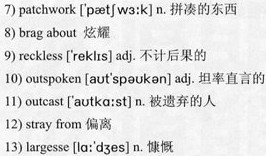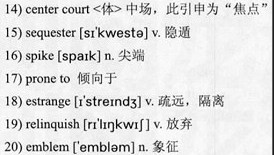文字难度:★★★
We live in the age of the fiercely successful “amazing girl.” Girls 1)outnumber boys in college and graduate school. They graduate at higher rates. In high school, girls pursue more leadership roles and 2)extracurricular activities than boys do, and they are significantly more likely to see themselves as leaders.
我们这个年代,成就非凡的“厉害女子”处处可见。在大学和研究所里,女生的人数比男生多。女孩们的毕业成绩更优秀。在中学里,相比男孩们,女孩们担当着更多的领导角色,并且参加更多的课外活动,而且相比以往,倾向于自视为领导者的女子的数量也大增。
 But if their college applications are3)stamped with twenty-first-century girl power, girls’ psychological résumés 4)lag generations behind. The Curse of the Good Girl 5)erodes girls’ ability to know, say, and manage a complete range of feelings. It urges girls to be perfect, giving them a troubled relationship to integrity and failure. It expects girls to be selfless, limiting the expression of their needs. It demands 6)modesty, depriving girls of permission to commit to their strengths and goal. It diminishes assertive body language, quieting voices and weakening handshakes. It reaches across all areas of girls’ lives: in their interactions with boys and other girls, at school, at home, and in extracurricular life. The Curse of the Good Girl cuts to the core of authentic selfhood, demanding that girls curb the strongest feelings and desires that form the 7)patchwork of a person.
But if their college applications are3)stamped with twenty-first-century girl power, girls’ psychological résumés 4)lag generations behind. The Curse of the Good Girl 5)erodes girls’ ability to know, say, and manage a complete range of feelings. It urges girls to be perfect, giving them a troubled relationship to integrity and failure. It expects girls to be selfless, limiting the expression of their needs. It demands 6)modesty, depriving girls of permission to commit to their strengths and goal. It diminishes assertive body language, quieting voices and weakening handshakes. It reaches across all areas of girls’ lives: in their interactions with boys and other girls, at school, at home, and in extracurricular life. The Curse of the Good Girl cuts to the core of authentic selfhood, demanding that girls curb the strongest feelings and desires that form the 7)patchwork of a person.
但如果说女孩们的大学申请表显示出了21世纪女孩的能力,她们的心理履历表则显露出远远落后的心态。“好女孩”的紧箍咒削弱了女孩们了解、述说以及应对全部感受的能力。它促使女孩们往“完美”发展,使她们不能诚实面对自我与失败。它限制女孩们表达自己的需求,期望她们成为无私的人。它要求女孩们谦逊,不让她们全力发展特长追求目标。它限制了她们自信地用肢体语言表现自己,使她们愈发不愿说出自己的想法,握起手来也软弱无力。它蔓延至女孩们生活的方方面面:在与男孩们以及其他女孩的互动中,在学校、家庭,以及课外生活中。“好女孩”的紧箍咒直指其真实自我的核心,要求其压抑形成一个完整的人所应有的各种最强烈的感受和渴望。
The curse is the product of a culture that remains confused about gender equality. In Meeting at the Crossroads, Lyn Mikel Brown and Carol Gilligan documented a crisis of connection in girls approaching adolescence. Girls withheld their true thoughts and feelings in an attempt to maintain “perfect” relationships. Nearly twenty years later, little has changed. In a study by Girls, Inc., 74 percent of girls said they were under a lot of pressure to please everyone. Nearly half the girls surveyed said that “girls are told not to 8)brag about the things they do well” and that the “smartest girls in my school are not popular.” A majority said they were expected to speak softly and not cause trouble.
这紧箍咒源于整个文化对性别平等这一概念的迷惑不解。在《在十字路口相遇》一书中,莲·迈克·布朗和卡罗尔·吉利根借助相关材料证明了接近青春期的女孩们身上存在着一种关系危机。女孩们抑制她们真实的想法和感受,企图维系和他人的“完美”关系。在此之后的将近20年里,这一情况几乎没有任何改变。在由美国慈善组织“女子协会”开展的一项研究中,74%的女孩们说她们为了取悦每个人而承受着许多压力。接受调查的女孩中,有将近一半的人说,“人们告诉女孩们不要夸耀自己擅长的事”,以及“在我的学校里,那些最聪明的女孩并不受欢迎。”大部分女孩说,人们希望她们说话轻柔,不招惹麻烦。
The Bad Girl was the picture of female failure, a 9)reckless rejection of femininity, everything a girl was told not to be. She was the odd girl out with a bad reputation, low to no status, and few friends.
而“坏女孩”则展示了女性失败的一面,她们不计后果地抗拒女性特质——每个女孩都被告知应当持有的品质。坏女孩性格乖张、名声不好、卑微低下、没有朋友。
Yet she was also independent and authentic. The Bad Girl was 10)outspoken (speaks her mind) and self-possessed (proud), a risk taker (rule breaker), and a critical thinker (artistic, rebel, doesn’t care what people think). She was comfortable being in charge (center of attention). But she was nothing if not an 11)outcast, an example to Good Girls of what happened when you 12)strayed from the program. Being Bad was social suicide: a big, red F in Girl.
然而,她却也独立而实诚。“坏女孩”直言不讳(说出自己的想法)、自持自重(骄傲得意)、勇于冒险(打破常规)、具有批判性思维(有艺术性、反叛、不在乎人们的想法)。她处于领导角色(人们的焦点所在)时会感觉很自在。但她们无非只是“弃儿”,是人们给“好女孩”讲述离经叛道的后果时会引用的一个例子罢了,根本无足轻重。成为坏女孩就是在社会上自绝其路:对女孩们来说是大大的败笔。
Being Good is a richly rewarded pursuit. Good Girls enjoy social 13)largesse, holding 14)center court in cafeterias and dominating leadership positions at school. Yet many of these overachieving girls learn to succeed by 15)sequestering the most genuine parts of their developing selves. Mia was fourteen, overbooked, and under slept: a golfer, avid volunteer, and staff writer for the school newspaper. But, she told me:
而“成为好女孩”则报酬丰厚。“好女孩”在社会上处处享受厚遇,在自助餐厅里是人们的焦点所在,在学校里占据着领导地位。然而,这些“厉害女子”中,有许多学会了通过抑制她们处于发展中的自我最真实的部分来获得成功。14岁的米亚睡眠不足,她的时间排得过满:打高尔夫球,热心于志愿者活动,还当校报记者。但她告诉我:
“When I’d go to school, a switch went on. Time to be Mia that everyone wants to be friends with...like everyone loves me, I don’t do bad things, I’m just Miss Perfect. My parents love me. I do all the activities that everyone wants to do. If my teachers ask me to do something, I’ll do it. One of those pleasing people.”
“一回到学校,我就会转换到另一种状态/样子。是时候变成米亚——一个人人都想与之交朋友的人……仿佛每个人都喜欢我,我也不会做坏事,我就是个‘完美小姐’。我的父母爱我。我参与所有人都想参与的活动。如果我的老师让我去做一些事,我会去做。反正就是扮演一个讨人喜欢的人。”
Good Girl pressure threw a “switch” and split Mia’s personality. It was as if, she told me, “I had two identities.” To be Good, Mia had to project a false self to the world, acting one way in public and another way in private. She would behave one way to someone’s face and another way behind her back; one way in person, another way online.
社会对“好女孩”的看重成了一种压力,促使米亚出现了“角色转换”以及人格分裂的情况。她告诉我,那就好像“我有双重身份。”要成为好女孩,米亚在世人面前得制造投射一个虚假的自我形象,“台上”是一个样,“台下”又是另一个样。人前人后,她会有两种截然不同的举动。真人是一个形象,在网上的言谈又是另一回事。
Psychologist Roni Cohen-Sandler observed a 16)spike in stress levels and psychological crises among girls who, she writes, are “17)prone to becoming 18)estranged from their inner lives...[They] are so busy living up to others’ expectations that they either don’t develop or eventually 19)relinquish their own goals. They are so focused on achieving external 20)emblems of success that they don’t get the chance to figure out what really excites them and gives them pleasure. They barely know who they are or who they want to become.”
心理学家朗妮·柯恩—桑德拉观察到以下这类女孩其压力水平中的一个峰值及其心理危机,于是这样写道:“倾向于与其内心世界隔离……(她们)忙于迎合他人的期望,以致她们要么根本不去想自己的目标,要么最终放弃目标。她们一心要争那些所谓成功的外在虚壳,从而没有机会弄明白真正令自己兴奋并给自己带来愉悦的是什么。她们几乎不清楚自己是谁,或是自己想成为怎样的人。”
At what price is success? Many of the most accomplished girls are disconnecting from the truest parts of themselves, sacrificing essential self-knowledge to the pressure of who they think they ought to be.
成功的代价有多大?那些最为成功的女孩们中,很多都脱离了自我中最真实的那个部分,牺牲了最必不可少的那份自知自重,而屈服在外界的压力下,去做她们以为自己应当成为的那种人。
The curse is not confined to overachievers or to girls’ external pursuits. The pressure to be Good runs deep into the core of the self, 21)circumscribing a girl’s ability to know, express, and accept her most challenging feelings.
这个紧箍咒并非局限于那些成就斐然的女孩,或是她们的外在追求。成为“好女孩”的压力根深蒂固,限制了一个女孩了解、表达以及接受自己内心最不赞同的感受。
Placed 22)at odds with their most important feelings, many do not develop the skills to speak their minds when they need to, or the skin to endure the claims of someone else. Lacking a full emotional vocabulary or the permission to use it, some girls turn inward, 23)ruminating self-destructively. Others become explosive, able to 24)articulate little more than anger and frustration. The psychological muscles a girl uses to manage difficult feelings begin to 25)atrophy. Emotional intelligence is compromised, 26)stunting healthy self-expression: the more Good girls try to be, the more they must 27)discredit themselves. These toxic lessons in relationship and conflict management follow many girls into adulthood.
被置于与自己最重要感受背道而驰的这种境地,许多女孩没有培养自己在有需要时说出内心想法的能力,也没磨练出一副厚脸皮来拒绝别人的种种要求。由于缺乏一套完整的情感词汇,或是没有获得允许去使用,一些女孩把事情憋着,反复思考,以一种自毁的方式钻牛角尖。另一些则选择爆发,但能清楚地表达出来的只是怨怒和沮丧。女孩用来应对各种焦虑情绪的“心理肌肉”开始萎缩。情商遭遇妥协,阻碍了利于健康的自我表达:女孩们越是想成为“好女孩”,她们就越来越自我怀疑。这些有关人际关系和矛盾处理的教训危害十足,会跟随许多女孩进入成年期。
To be absolutely kind and selfless is impossible, making Good a finish line girls never get to cross. As a result, girls who 28)aspire to Goodness are ruthlessly hard on themselves. When the standards for selfhood are beyond reach, self-acceptance is futile. Girls become their own worst enemies. The terms of being an acceptable girl are 29)rigged: Good Girls are doomed to fail.
要成为绝对善良和无私的人是不可能的,这使得女孩们永远跨不过“好”这一终极界限。结果,立志成为“好女孩”的她们严守戒律,自克自抑。当“自我成就”的标准是那么高不可攀时,“自我接受”也变得无从谈起了。女孩们成为了自己最大的敌人。要成为被社会接受的女孩,根本就是走进一场早被人做了手脚的赌局:“好女孩”注定是输家。






